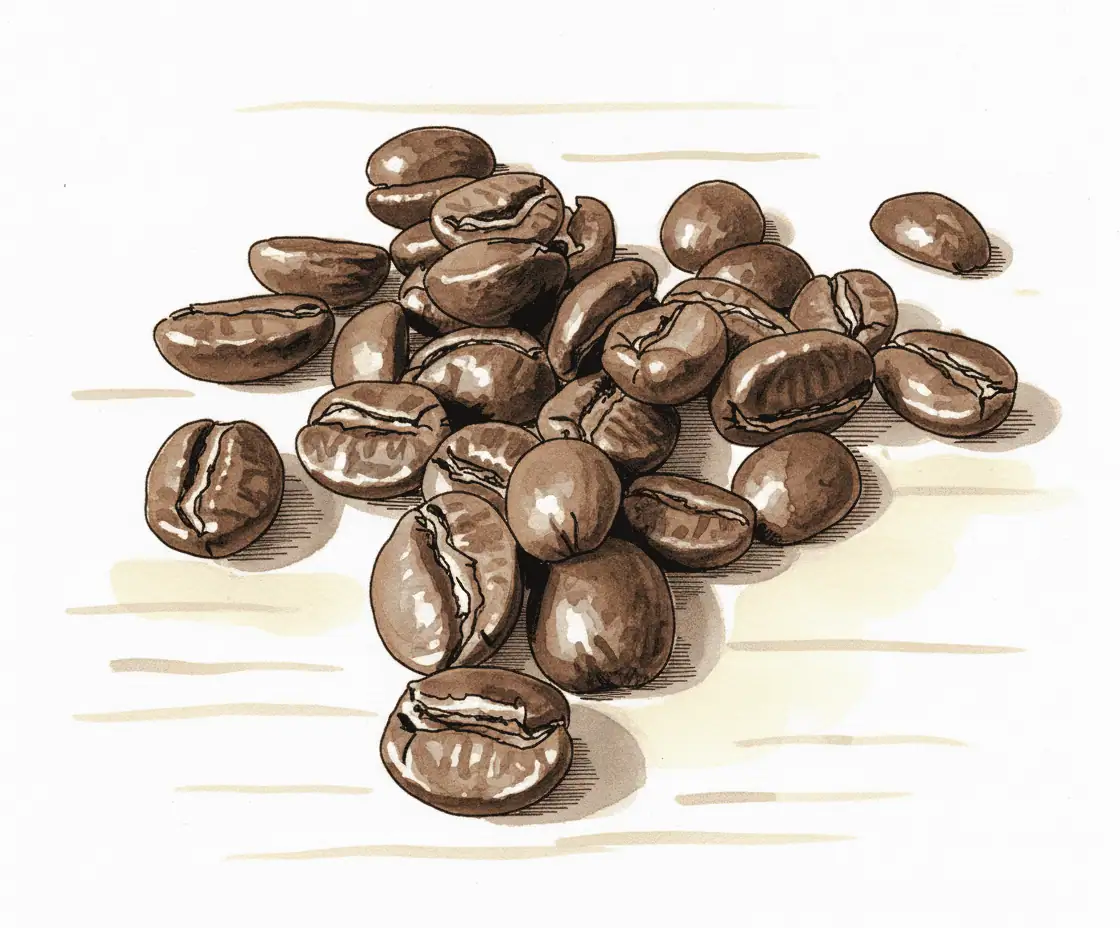High-Altitude Coffee
At high altitudes (above 1500 meters), coffee cherries ripen more slowly, resulting in denser beans with pronounced aromas. The lower temperature and thinner air foster a complex flavor profile, often characterized by high acidity and fruity, floral, or wine-like notes. Regions such as Ethiopia and parts of Latin America are known for their high-altitude coffees, which are prized for their refined and sparkling character.
High‑altitude coffee beans

Brazil Santos Espresso
Brazil Santos Espresso van Boot Koffie komt van Fazenda São Francisco da Bela Vista in Carmo de Minas. De Yellow Catuai arabica is natural verwerkt en licht tot medium gebrand, wat zorgt voor een zachte body en lage zuurgraad. Verwacht smaken van chocolade, hazelnoot, karamel en steenfruit met een zoete afdronk. Deze allrounder werkt prima…

Brazilië | Ellen Fontana (espresso)
Deze espresso roast komt van Fazenda Fronteiras in Socorro, São Paulo, op circa 1 350 meter. De koffie is vers gebrand op 15 08 2025 en behaalt een cuppingscore van 86. Verwacht een volle body met tonen van tropisch fruit, rode bes, gedroogd fruit, vanille en melkchocolade, met een lichte frisse zuurgraad en een sterke…

Brooklyn
Brooklyn is een espresso blend met 90 procent Brazilië en 10 procent Geisha uit Panama. De bonen komen van Fazenda JS in Mata de Minas en Finca Santa Teresa in Volcán. De branding richt zich op balans, vermoedelijk medium dark, met behoud van delicate aroma’s. Verwacht tonen van gekonfijte sinaasappel, praline en romigheid, met een…

Brotherhood
Brotherhood is a specialty blend from BeanBrothers, sourced from Nicaragua, Brazil, and Honduras, put together by Bruno, Silvio, and Omar. At Stadsbranderij Eindhoven it is freshly roasted weekly on a Giesen, with a medium roast that preserves balance and brightness. Expect notes of red fruit, milk chocolate, and cane sugar, with a clean finish. All components are naturally processed…

Buena Vista
Buena Vista is een lichte filterkoffie uit Huila in Colombia, rechtstreeks ingekocht bij Maricela Joven Penagos. De microlot wordt gewassen verwerkt en op 1750 meter gedroogd onder marquesinas, wat zorgt voor een schone, heldere kop. Verwacht romige hazelnoot, ahornsiroop en een frisse kersenafdronk, mooi in balans. De variëteiten Pink Bourbon en Papayo geven een verfijnd,…

Cafeïnevrije Colombia (Future Proof)
Deze cafeinevrije Colombiaanse koffie komt uit de hooglanden van Tolima en is een single origin van Supremo kwaliteit. De medium roast in kleine batches behoudt aroma en balans, met tonen van noot en donkere chocolade en een medium body. De CO2 decafeinatie verwijdert cafeine zacht en milieuvriendelijk, zonder chemische oplosmiddelen en met minder dan 0,1…

Caimo Collective
Caimo Collective van Keen Coffee komt uit Pitalito Huila en wordt verbouwd door een collectief van kleine boeren. De koffie is licht gebrand als Colombiaanse espresso met een heldere, fruitige structuur. Verwacht proefnotities van gedroogde abrikoos, guave en rijke honingzoetheid, gebalanceerd en soepel. De bonen worden gewassen verwerkt met zorgvuldige controle in elke fase, wat…

Cappuccino Melange
Deze krachtige espresso blend combineert 100 procent Arabica uit Brazilië, Costa Rica, Guatemala en Ethiopië. De medium tot licht donkere branding geeft een volle smaak met tonen van bittere chocolade, cacao, vanille en een bloemig fruitig accent. Door de mix van natuurlijke en gewassen verwerkingen blijft het profiel helder en gebalanceerd. Ideaal voor espresso, cappuccino,…

Chelbesa
Deze Chelbesa Yirgacheffe komt uit de Gedeb zone in Ethiopië, verzameld bij Chelbesa One Washing Station en beheerd door SNAP Coffee. Op 1950 tot 2200 meter groeien Korume en Wolisho landrace variëteiten. De koffie is licht tot medium geroosterd voor filter of espresso, met heldere tonen van limoen, honing, bergamot en florale nuances, plus hints…

Chiapas
Engrano Chiapas komt uit de staat Chiapas in zuidelijk Mexico, waar koffie groeit op vulkanische bodem in de Reserva El Triunfo op 1200 tot 1800 meter. De bonen zijn 100 procent Arabica met variëteiten Mundo Novo en Bourbon, gewassen verwerkt voor een schone, complexe kop. De lichte branding benadrukt een medium body met proefnotities van…

Chimi
Chimi is de eigen blend van SOCOCO met bonen uit Guatemala en Uganda. De blend, vermoedelijk medium roast, brengt tonen van chocolade, noten en een lichte fruitigheid samen. De washed verwerking benadrukt helderheid en zuiverheid, waardoor de smaak zacht en toch gelaagd blijft. SOCOCO legt de nadruk op sociale impact en transparantie in de keten,…

City Limits
City Limits is een espresso blend met 70 procent Brazilië Inacio Soares F2 en 30 procent El Salvador Rodolfo Ruffati Red Bourbon. De bonen groeien tussen 880 en 1650 meter en worden verwerkt met honey en gewassen methodes voor een balans tussen zoetheid en helderheid. De medium tot medium donkere roast benadrukt tonen van donkere…

Colombia
Op Kop Colombia is een medium roast met een helder, fruitig profiel. De bonen komen uit regio’s als Huila, Antioquia en Tolima en worden gewassen verwerkt voor een zuivere, frisse smaak. Verwacht tonen van amandel, kers, chocolade en karamel, ondersteund door een medium body en milde zuurgraad. Geschikt voor espresso, filter, French press en percolator,…

Colombia
Deze koffie uit Colombia komt uit Huila en wordt als single origin gebrand door Borgman en Borgman. De bonen groeien rond 1800 meter en ondergaan een gewassen proces, wat zorgt voor heldere smaken en een fijne body. Verwachte tonen zijn rozijn, chocolade en fruit, passend bij het terroir van Huila. De branding gebeurt vers in…

Colombia
Colombiaanse koffie uit Cauca komt van het Papayan plateau met vulkanische bodem en schaduwbomen. Het gaat om 100 procent Arabica met variëteiten Excelso en Supremo. De branding is richting medium wat zorgt voor een zachte body met frisse zurigheid, rijpe fruittonen, kers en noot. Handmatig geplukt, 12 uur gefermenteerd en zongedroogd voor consistente kwaliteit. Geschikt…

colombia – acevedo
Colombia Acevedo uit Huila staat bekend om schone, evenwichtige koffie van 2000 meter hoogte. White Label Coffee biedt een gewassen oogst 2024 met variëteiten Castillo, Caturra en Colombia. Het brandprofiel neigt naar medium, met tonen van karamel, zwarte thee en nougat, waardoor zoetheid en nuance in balans blijven. Filtermethoden zoals V60 en Chemex benadrukken helderheid,…
High Altitude (above 1500 meters)
Welcome to the world of high-altitude coffee! When you think of beans grown above 1500 meters, words like “refined,” “complex,” and “vibrant” often come to mind. But why exactly? In this article, we’ll dive into the effects of high altitudes on your espresso, the chemical composition of the beans, processing methods, and much more.
How altitude affects espresso flavor
At high altitudes, coffee cherries mature more slowly. This gradual ripening process allows sugars and acids in the fruit to develop over time, giving the beans ample opportunity to build a full range of flavors. When you use these beans for espresso, you’ll often taste a refined acidity and floral or fruity characteristics—think subtle citrus or berry aromas with a bright, almost “sparkling” quality. If you enjoy a delicate espresso, high-altitude beans are an excellent choice.
Chemical composition: density, sugars, and acids
Because the air is thinner and cooler at higher elevations, coffee trees receive less oxygen and grow at a slower pace. This results in denser beans that often exhibit higher acidity. The sugars develop more gradually, and the extended ripening contributes to a complex flavor structure. You end up with a bean that balances sweetness and complexity, translating into a lively cup of coffee. The increased density also impacts roasting profiles: roasters usually take extra care to highlight all those nuanced flavors.
Processing methods at high altitude
Thanks to the cooler, sometimes more humid climate, some coffee farmers opt for processing techniques that emphasize their beans’ unique characteristics. In many high-altitude regions, the washed method is especially popular, as it accentuates fruity and floral notes. Removing the pulp and mucilage under carefully controlled conditions allows any impurities to wash away, leaving a clean, pure flavor. There’s also some experimentation with natural and honey processes in these regions, though washed processing is often the standard for maintaining clarity.
Climate and microclimate
High-altitude environments have unique weather conditions: cooler nights, milder days, and often more rainfall. In some places, mist clings to the mountainsides, creating microclimates that can vary even from one slope to the next. This contributes to the slow ripening of cherries and the development of complex aromas. On the flip side, coffee farmers face challenges like fungal diseases in damp conditions, but the reward is a flavor profile cherished worldwide.
Yield and resilience
Growing coffee at 1500 meters or higher isn’t easy. The trees often produce fewer cherries because the plants expend more energy just to survive in cooler temperatures. Still, the beans command a premium for their pronounced quality and distinctive taste. Many farmers form cooperatives to share knowledge about cultivating coffee under these challenging conditions, employing innovative irrigation methods or using shade trees to protect their coffee plants.
Choosing coffee varieties
Not all coffee plants thrive at 2000 meters. Farmers often select varieties that can handle the cold and resist diseases, such as certain Arabica strains (like Bourbon, Typica, or Geisha). These varieties are known for their potential to develop subtle flavor nuances—a perfect match for the special circumstances high altitudes provide.
All in all, coffee from high altitudes isn’t just any cup of joe. Expect floral notes, a lively acidity, and refined aromas that will delight anyone seeking a bright and complex coffee experience.
